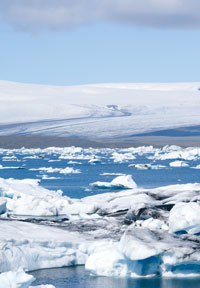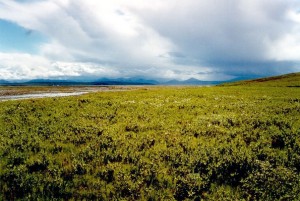
Energy Development in the Arctic – Threats and Opportunities
-Cross-Posted from Andrew Holland’s “Energy, Security, Policy” Blog-
One of the most contentious domestic political issues in the debate between energy development and environmental policy for over 20 years has been how to develop America’s energy resources in the Arctic. As Shell makes preparations to send offshore drilling rigs into the Beufort and Chukchi Seas north of Alaska, I thought it would be important to walk through the history of energy exploration in Alaska.
Two weeks ago, I spoke as a part of a lecture series by the Massachusetts-based Manomet Center aboutenergy development and ecosystems in the Arctic. Manomet is a conservation sciences organization that was founded to study migratory shorebirds; I was paired in the lecture with Stephen Brown, one of Manomet’s foremost experts on Alaskan shorebirds. The event was very interesting because it allowed a frank and open discussion of the threats and opportunities in the Arctic. The discussion below is adapted from my presentation.
Long History of Arctic Energy Exploration
Since the 1920s, Americans have known that there were vast reserves of oil in the North Slope of Alaska, when the Navy was given the territory now known as the National Petroleum Reserve as reserve for oil production to supply the fleet as it transformed from coal to oil. The reserve was never tapped, however, because of new finds in more accessible areas like Texas, California, and Oklahoma.
In 1968, a vast reserve of oil, the largest single field in the U.S., was discovered in Prudhoe Bay. However, the oil field could not begin commercial production until there was a way to deliver the oil to markets in the Continental U.S. or around the world. First, an icebreaking oil tanker, the Manhattan was sent through the Northwest Passage to test the feasibility of such a commercial route. When that proved too difficult, it was decided that the only possible route to market for Alaska’s oil was a pipeline from the North Slope.
This was a contentious debate, as landowners and native people wrestled with the environmental impact of such a pipeline. However, with the onset of the first Arab oil crisis in 1973, Congress authorized the expedited building of the Trans Alaska Pipeline System (TAPS). Completed in 1977 at a cost of $8 billion (about $32 billion in today’s dollars), the pipeline marked a significant infrastructure investment. It transports crude oil from Alaska’s North Slope, across 800 miles of tundra, rugged mountains and rivers to Valdez, North America’s northernmost ice-free port.
TAPS carries approximately 15 percent of the nation’s domestic oil production and has transported more than 15 billion barrels of crude oil in its lifetime. Importantly, it has a maximum daily capacity of 2.136 million barrels of oil, although it has never transported its full capacity.
In 2011, Alaska’s North Slope oil production was 562,000 barrels of oil per day. That means that the pipeline is only operating at about ¼ capacity. At its peak production in 1989, Prudhoe Bay was producing about 2 million barrels per day – almost at the TAPS capacity. I don’t know exactly why the field has seen a 71% drop in production over the last 22 years, but I would suspect that it can be attributed to a natural declining field.
ANWR: Trying to Find New Oil Production to Fill the Pipeline
The Arctic National Wildlife Reserve (ANWR) is the largest protected wilderness in the United States and was created by Congress under the Alaska National Interest Lands Conservation Act of 1980. However, unlike other Wilderness areas that are protected from development in perpetuity, under this act, a 1.5 million acre sector of ANWR, the so-called 1002 Area, was designated for study of its hydrocarbon reserves. The Act left it up to a later Congress to open the Area to exploration.
A 1998 report by the U.S. Geological Survey estimated that there was between 5.7 billion barrels and 16.0 billion barrels of technically recoverable oil in the 1002 Area. However, we simply cannot know the actual production potential of the area because exploration wells have never been drilled. The USGS estimates are based on the geologic formations of adjacent lands, not actual exploration within ANWR.
In 1989, Congress was preparing legislation that would open the 1002 Area of ANWR to oil exploration, and it was predicted to ‘sail through’. However, the Exxon Valdez disaster in March of that year quickly stopped consideration of the legislation. The return of Republicans to power in Congress after the 1994 election saw the issue return in Congress. President Clinton vetoed an effort to open ANWR to drilling in 1996, and the early years of the Bush Administration saw several close votes on opening the refuge to drilling. Ultimately, however, the environmentalists won the argument, and ANWR has remained closed.
By the time I was working on staff in the Senate, in 2006, the issue had become ritualized. Everyone knew how each Senator was going to vote on an annual vote, Senator Ted Stevens would get very angry, but the legislation would ultimately fail. Since the 2010 mid-term elections, House Republicans have included an opening of ANWR in their drilling bills, but the Democratic Senate has not even taken them up, and President Obama would veto them.
Offshore Drilling in Alaska’s North Slope
Since 2007, a warming Arctic sea has seen dramatic reductions in summer sea ice. This has allowed energy companies like Shell to contemplate how to extract some of the 22% of the world’s undiscovered energy resources that the US Geological Survey estimates are under the Arctic Sea.
Shell is preparing to send exploration ships to the Chuckchi and Beaufort Seas this summer to explore for oil. They have received permission from the EPA and Department of Interior, and are awaiting permits from the National Marine Fisheries Service and the Fish and Wildlife Service. While these are expected to go through, we should expect to see some significant litigation between now and then. Shell plans to bring about 30 ships and over 500 people to handle the exploration operations. The U.S. Coast Guard, too, will operate a full-time presence in the Arctic this summer for the first time, with a Cutter on patrol at each of the drilling sites. There will be more people off that stretch of beachfront — over 1000 miles from the nearest deepwater port — than probably has ever been there.
I understand that the sea floor in this area is fairly shallow, so the technical problems of drilling at high depth that we all became familiar with during the Deepwater Horizon disaster will not be there. Instead, we will see entirely different threats, like surface ice and severe storms. Shell has experience operating in Russia’s Sea of Okhotsk, but this will remain an extreme environment.
If all goes well, Shell anticipates that the first production of oil will begin in less than ten years, and peak production will be about 1.7 million barrels of oil per day.
Blocking ANWR Production led to Offshore Drilling
Notably, that production figure for offshore oil will be just enough to bring the TAPS back up to full capacity. I believe that if exploration in ANWR had not been blocked, there would not be a push to drill offshore. With new oil pumping through the pipeline, there would not have been enough capacity to accommodate offshore drilling as well. However, as it is now, offshore drilling is the only way to increase capacity to meet the capacity limits of the pipeline. So long as this already existing infrastructure is not fully utilized, there will be pressure, both from oil companies and from Alaska’s politicians, to fill the pipeline.








[…] Holland: Energy Development in the Arctic – Threats and Opportunities […]
[…] and the implications of the shrinking ice cap. Brigadier General Kenneth Lewis spoke about the new challenges and opportunities presented by the opening up of the Arctic Ocean. He acknowledged that increasing human activity in […]